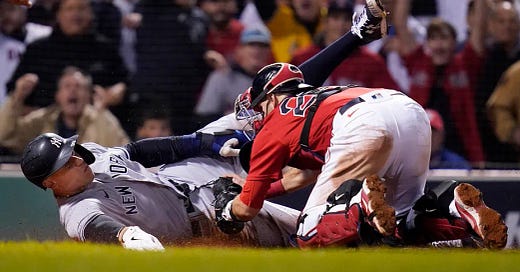Sending the Runner is Pro-Labor
Sports fans have this tendency to overrate the importance of strategic decisions. This makes sense, on some level. Strategy is something fans can understand, and intelligently weigh in on. You can say something like, “I would have gone for it fourth down,” or, “I would have thrown a different pitch there” and you might be right, or at least you might have a point. But there isn’t much to be said when a player simply drops a pass or strikes out.
So fans sometimes overlook that what players do is way more important than the strategic decisions made by coaches and managers. A play in the AL Wild Card game this week exposed this tension. In the sixth inning, with the Yankees down 3-1 and one out, Giancarlo Stanton was up with Aaron Judge on first base. Stanton hit a towering line drive that in most ballparks would be a home run or at least a double into the gap, but because of the ridiculous, antiquated dimensions of Fenway Park, it hit the Green Monster and bounced back to center fielder Kiké Hernandez.
The Yankees’ third base coach, Phil Nevin, decided to send Judge home, but he was thrown out at the plate on a play that wasn’t all that close. Then Joey Gallo popped out and the inning was over—the last rally the Yankees would have in a game they lost 6-2.
Nevin’s decision to send Judge was criticized in real time, and became even more of a focus after the game. Alex Rodriguez spent much of the rest of the ESPN broadcast killing the move, and Buster Olney did the same on Twitter.

Personally, I think the strategic reasoning here is bad. In particular, Olney and ARod both suggested that when you’re losing, you should be more conservative, which seems like the opposite of the truth. The Yankees’ offense had been struggling since DJ LeMahieu went on the IL—they’d scored only six runs in their previous 32 innings going into the sixth, and the Rizzo/Judge/Stanton stretch of the lineup was one of the few that could be relied on to drive in runs. The next hitter was Joey Gallo, who strikes out in more than 1/3 of his plate appearances and has only two sacrifice flies in his career—not the kind of hitter you can count on to get the runner in from third. But the Yankees needed to get runs on the board, and so this seemed like it was worth the risk.
But more importantly, all the discussion about Nevin’s decision ignored what happened on the play itself, which required a good throw from Hernandez and then an amazing relay from Xander Bogaerts to get Judge at the plate. A rendering of the play from MLB FieldVision captures what actually happened.

You can see here that when Nevin made the decision to send Judge, the ball had scooted past left fielder Alex Verdugo and was just being fielded by Hernandez. Bogaerts wasn’t even facing the ball. By the time the throw gets to Bogaerts, Judge was halfway to the plate. Then Bogaerts catches and releases the ball in less than a second, throwing a rocket line drive from short center field to home plate to get Judge. It’s a pretty great play in a crucial situation.
Yet in all the discussion about the play, you’d think Phil Nevin played a bigger role than either Bogaerts or Aaron Judge. When Joe Posnanski wrote about the play in his newsletter, he wrote:
“Now, you could make the argument… that it took two really good throws to get Judge at the plate, and as such it was worth taking the chance. I admit having no use for that particular argument; these are major league players, the best in the world, and betting on them to make poor throws is like going all-in on the hopes of catching an inside straight. You might get lucky. You probably won’t. And it’s no way to win a baseball game.”
This is such a depressing way to view baseball, or any sport. To imagine the players as simply autonomous robots who never make mistakes is not only idiotic, but it sucks all the fun out of the game. Moreover, it equates anything less than a perfect play with a “poor throw.” Had Bogaerts taken a fraction of a second longer on the transfer… had the throw been six inches up the first base line… had it bounced just once… none of these things would have been a “poor throw,” but if any of them had happened, then Judge is probably safe. That thin margin for error is what makes the game so exciting.
But Posnanski’s view—and he’s really just articulating the perspective of everyone focusing on Nevin’s decision—is that all that is to be expected. Getting any result other than the one we got would just be “lucky.” All the important things are done by coaches and managers pressing buttons, not the players who actually make the plays.
Perhaps I am biased, since I did not disagree with sending Judge. Or perhaps the Gary Sanchez play from last month, when Jonathan Villar scored after the ball beat him by about 40 feet, simply made too much of an impression. Surely that Sanchez play was a fluke, and the Bogaerts throw was far closer to the modal outcome. But the whole point is that there is a range of outcomes in baseball—that’s what makes it fun—and the players are the ones who determine which we get to see.



